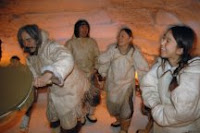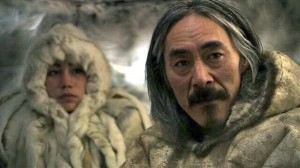 |
Isuma Independent Inuit Film — the word isuma means to think in Inuktitut — produced The Fast Runner (Atanarjuat) in 2000. Acted entirely by Inuit people, with dialogue in their native language, the film was a retelling of an ancient Inuit story of jealousy and murder: propelled by a primordial patricide, an evil spirit entered into a tiny Inuit community, manifest as the bitterness, jealousy, and murderous rage of the leader and his son. The hero — and the tale is without doubt a heroic journey — was Atanarjuat, the fast runner, who, in an excruciating ten-minute sequence, fled his pursuers, naked and barefoot, across the Arctic ice.
The Arctic landscape is, of course, remarkable — vast fields of snow or rock, in which humans and their habitations seem to disappear entirely. Moreover, the film clearly showed the daily life of the Inuit, all the more effectively for being an understated part of the background — how they prepare their food, build their iglus, provide lighting, construct their clothing, travel and hunt, preserve water, and use their all-purpose ulu knife. The film also showed the intricate social structures and complex personal and political interactions of a small isolated indigenous community. The film was altogether worth seeing, on multiple levels.
After the success of The Fast Runner, Isuma began their next project — depicting a series of events that took place in 1922, when Inuit shamanism was replaced by Christianity. Producer Zacharias Kunuk was inspired to make the film for “a first audience that is Inuit: elders who are still alive and young people looking for a future beyond boredom, unemployment and suicide. It tries to answer two questions that haunted me my whole life: Who were we? And what happened to us?” The film is called The Journals of Knud Rasmussen.
 |
The story is based on the journals of explorer and adventurer Knud Rasmussen, who recorded the words and life story of the last great Iglulik shaman, Avva, during his Fifth Thule Expedition across the Canadian Arctic. In the film, the great shaman Avva and his family are living on the land some distance from Iglulik, his home community that lately has taken up the teachings of Christian missionaries. Rasmussen pays Avva a visit, accompanied by two fellow Danes: trader Peter Freuchen and anthropologist Therkel Mathiassen. Rasmussen hears and records Avva’s life story and that of his wife Orulu. Their son, Natar, impulsively agrees to guide Freuchen and Mathiassen north to Iglulik. After a celebration, Rasmussen leaves to head west while Avva, facing strong headwinds, sets out with his family and guests en route for home. His beautiful daughter, Apak, has troubling dreams about the road ahead.
Like The Fast Runner, this film moves with the pace of the Arctic seasons. Yet there is no question that the film becomes more and more absorbing as you enter into its mythic rhythms.
Reviews of The Journals of Knud Rasmussen can be found on Rotten Tomatoes and IMDb.
Isuma has taken the bold step of making an entire fourteen-minute scene from the movie available on YouTube. This is the scene in which Avva tells his life story and his shamanic philosophy. It is a remarkable reconstruction of a shamanism predating significant contact with either Europeans or Christianity.

- Previous Post: What Can Shamans Heal?
- Next Post: Pucalupuna
- More Articles Related to: Indigenous Culture, Shamanism


